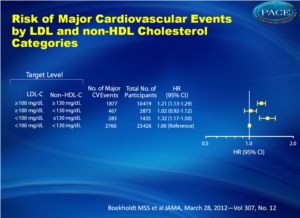Non-HDL strongest events predictor during statin treatment
04/04/2012
Among patients treated with statins, on-treatment levels of non-high-density lipoprotein (non-HDL) cholesterol may be best for predicting future cardiovascular events. Findings suggest that non-HDL cholesterol may be a more appropriate target for statin therapy than LDL cholesterol.
Association of LDL cholesterol, non-HDL cholesterol, and apolipoprotein B levels with risk of cardiovascular events among patients treated with statins: a meta-analysis.Literature - Boekholdt SM et al, JAMA. 2012 Mar 28;307(12):1302-9.
Boekholdt SM, Arsenault BJ, et al.
JAMA. 2012 Mar 28;307(12):1302-9.
Among patients treated with statins, on-treatment levels of non-high-density lipoprotein (non-HDL) cholesterol may be best for predicting future cardiovascular events. Findings suggest that non-HDL cholesterol may be a more appropriate target for statin therapy than LDL cholesterol.
Background
In current guidelines, LDL-C levels are used as primary target for lipid-lowering therapy. This meta-analysis evaluated whether the association of non-HDL-C and apoB with cardiovascular risk was stronger than that of LDL-C.
Methods
Individual patient data were obtained for 62.154 patients from 8 trials published between 1994 and 2008.
Main results
Adjusted hazard ratios for major cardiovascular events per 1-SD increase were as follows:- LDL cholesterol: 1.13 (95% CI 1.10 to 1.17)
- Non–HDL cholesterol: 1.16 (95% CI 1.12 to 1.19)
- Apolipoprotein B: 1.14 (95% CI 1.11 to 1.18)
Conclusion
Among statin-treated patients, non-HDL cholesterol had a stronger association with risk of major cardiovascular events than LDL cholesterol. Changes in non-HDL cholesterol also explained a larger proportion of the atheroprotective effect of statin intervention than did LDL cholesterol and apolipoprotein B.Author’s comment
Abstract
CONTEXT: The associations of low-density lipoprotein cholesterol (LDL-C), non-high-density lipoprotein cholesterol (non-HDL-C), and apolipoprotein B (apoB) levels with the risk of cardiovascular events among patients treated with statin therapy have not been reliably documented.OBJECTIVE: To evaluate the relative strength of the associations of LDL-C, non-HDL-C, and apoB with cardiovascular risk among patients treated with statin therapy.
DESIGN: Meta-analysis of individual patient data from randomized controlled statin trials in which conventional lipids and apolipoproteins were determined in all study participants at baseline and at 1-year follow-up.
DATA SOURCES: Relevant trials were identified by a literature search updated through December 31, 2011. Investigators were contacted and individual patient data were requested and obtained for 62,154 patients enrolled in 8 trials published between 1994 and 2008.
DATA EXTRACTION: Hazard ratios (HRs) and corresponding 95% CIs for risk of major cardiovascular events adjusted for established risk factors by 1-SD increase in LDL-C, non-HDL-C, and apoB.
RESULTS: Among 38,153 patients allocated to statin therapy, 158 fatal myocardial infarctions, 1678 nonfatal myocardial infarctions, 615 fatal events from other coronary artery disease, 2806 hospitalizations for unstable angina, and 1029 fatal or nonfatal strokes occurred during follow-up. The adjusted HRs for major cardiovascular events per 1-SD increase were 1.13 (95% CI, 1.10-1.17) for LDL-C, 1.16 (95% CI, 1.12-1.19) for non-HDL-C, and 1.14 (95% CI, 1.11-1.18) for apoB. These HRs were significantly higher for non-HDL-C than LDL-C (P = .002) and apoB (P = .02). There was no significant difference between apoB and LDL-C (P = .21).
CONCLUSION: Among statin-treated patients, on-treatment levels of LDL-C, non-HDL-C, and apoB were each associated with risk of future major cardiovascular events, but the strength of this association was greater for non-HDL-C than for LDL-C and apoB.

